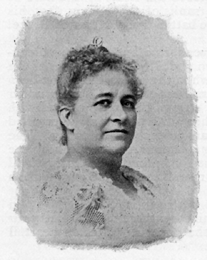SYNOPSIS OF A PAPER ON CHARLES LAMB.
By MRS. C. A. R. DEVEREUX.

|
| MRS. C. A. R. DEVEREUX. |
Mrs. Devereux's paper was both analytical and dramatic. She spoke at the outset of the peculiar quality of the wit and humor of Charles Lamb, as it shimmers and sparkles in his essays and sayings and gives luster to his letters. She said in brief what follows: To quote boldly his quaint and delicate fancies is like tearing a bunch of wood violets from their mossy nest and holding them up to the sunshine—they wither at the touch. Lamb's wit is not simply a tissue of jests and far-fetched conceits, but a combination of humor and pathos essentially different from that of any other man.
Taking her audience with her in a charmingly confidential manner the essayist looked in at the South Sea House, Oxford, Christ Church Hospital, and crossed the pleasant fields of Hampstead; lunched off roast pig with Bo-bo, and drank Hyson out of Bridget Elias' China teacups, with the mandarins on the saucers, and then made the acquaintance of the family at the rambling old house in Norfolk where Grandmother Field used to see the apparitions of the two golden-haired infants glide up and down the staircase near where she slept.
Then Mrs. Devereux touched upon the story of Charles Lamb's life, his griefs that make him venerated, his frailties that make us press our fingers to our lips and command silence.
His life is a story of insanity, and the shadow never left it. His sister Mary, in a moment of frenzy, killed her mother, an old, infirm invalid. His was the hand that snatched the knife from her grasp. It is enough to say that for thirty years afterward (he was then a man of twenty) he devoted himself to her with a singleness of purpose entirely without parallel. Talford says that when these fearful times came upon her she blazed out into descriptions of bygone days in jeweled words and speeches like those running through the works of the old comedy's masters.
An interesting portion of the essay was a description of an evening at Charles Lamb's humble quarters in the inner temple, with word pictures of Leigh Hunt, Hazlitt, Coleridge, Godwin, Talford and Holcroft, where the champagne was in the talk, whose aroma and effervescence has come down to us and will go on forever.
The essay concluded with a little circlet of Williant's, a few examples of Lamb's quaint and jocose speech that have escaped into notoriety so well presented that their luster was scarcely dimmed.
His was a many-sided mind. His wit wins us, his pathos woos us, his grand and simple nature fills us with equal awe and reverence. His is an influence that can never die.
We do not say, "I should have loved him had the self-same day but found us living, but I hold him dear now, at this moment, and if patient ears, wrapped in God's silence dimly now and then, catch echoes of the grateful love of men, Charles Lamb rests happily through all these years."

[Page 752]
Clara A.R. Devereux was born in Boston. Mass. Her parents were Zoeth and Phœbe Rich. She was educated at Oread Institute, Worcester; at Framingham and Bedford Academies. She has traveled extensively. She married Gen, Arthur Forrester Devereux, of Salem, Mass. Her special work has been editorials and correspondence on the staff of the Cincinnati Commercial Gazette. Mrs. Devereux enjoys the distinction of being one of the most brilliant writers on the Western press. Her ready wit and warm heart make her equally admired and beloved by all who know her. Her profession, journalism. In religious faith she is Episcopalian. Postoffice address Cincinnati, Ohio.